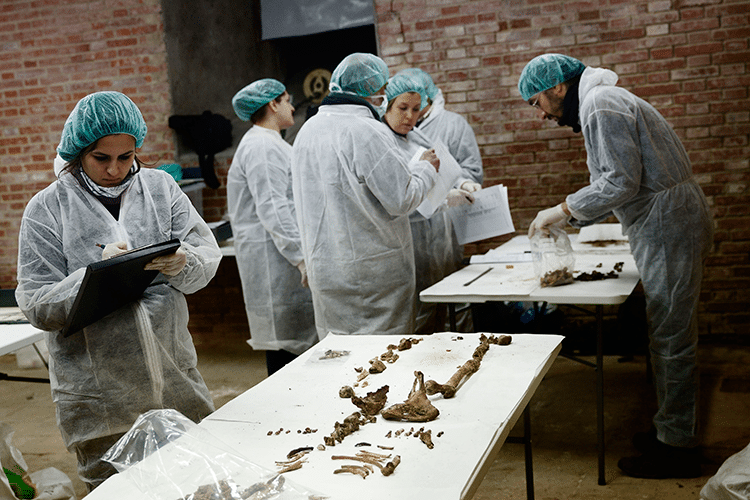Finding Cervantes’s bones

Daniel Ochoa de Olza/AP/Press Association Images
One hundred and twenty pages – that’s the amount of space we have per issue to digest the news of the previous three months. And with every issue, it turns out that 120 pages is not quite enough.
There are always stories we’d like to cover, but which don’t make the final cut. An example: On 17th March it was announced that the remains of Miguel de Cervantes Saavedra had been found in Madrid’s Convent of the Barefoot Trinitarians, nearly 400 years after his death. The bones of the Don Quixote author had been lost for centuries. We spoke to archeologist Almudena García Rubio, who coordinated the multidisciplinary project, about what it’s like to be looking for a 400-year-old corpse, and why it was important enough to warrant a year-long search that came with a price tag of €100,000.
In the end, we unfortunately couldn’t squeeze the interview into the print magazine, which is why we wanted to share it with you on the blog. Here’s what García Rubio told us.
“Cervantes is the father of the modern novel – Don Quixote is the world’s most translated book [after the Bible] – and he is the most important author in the Spanish language, so there was of a lot of interest in finding out where exactly he had been buried. It’s a great moment to bring to light more about his life and work now, because this year was the 400th anniversary of the publication of the second part of Don Quixote, and next year will mark the 400th anniversary of his death.
It was always known that Cervantes had been buried in [the Convent of the Barefoot Trinitarians], but back then it had been very small – only taking up two houses. In the century after his death, the nuns bought the neighbouring houses and turned it into an enormous convent. In the process, they lost track of the location of Cervantes’s grave.
I got involved about a year and a half ago and I’ve had moments where I thought that our chances of success were very limited. The most confusing moment was when we started excavating and we noticed there were a lot more graves in the crypt than we had thought. We thought we would find about 20 graves, but instead there were about 200. There was a layer with an 18th to 19th century children’s cemetery which the nuns didn’t know about and which wasn’t mentioned in the documents we had studied. What we were looking for turned out to be a layer underneath this cemetery.
There were also some good moments which stood out. For example when we started to realise that the children’s cemetery was actually in a very good state of conservation, with mummified remains including clothing. It’s great to find an unedited record like that because it expands our historical knowledge of the convent, the neighbourhood and Madrid. I was very happy about the find as an archeologist and anthropologist, but also as a Madrileña.
And of course there was the moment when we were almost done, thinking we wouldn’t find anything related to Cervantes and, in the last section we excavated, something started to appear which looked like what were searching for.
It was a great moment, but we were also slightly disappointed. Unlike the children’s remains, the bones in the deeper grave were in a very poor condition. The remains we found correspond with the historical information we had on the individuals who were buried in the crypt, but we can’t identify which bones belong to whom. We couldn’t find any signs on the bones of the injuries we know Cervantes had. That’s a real shame. Still, the team is satisfied overall. We found what we had set out to find – which isn’t always the case in archeological research – as well as a lot of unedited historical information about 17th century Madrid, about how funerals were conducted in the 18th century and about the convent.
We were very lucky to have access to several new technologies, like geo-radar, an endoscopic camera which enabled us to inspect niches with graves that were located behind a wall, and a scanner which allowed us to perfectly document the mummies we found without touching them and even reconstruct them with a 3-d printer. At the same time, doing extensive archive research and an adequate excavation are fundamental – these core archeological methods are now much the same as they were 20 years ago. You could have all the technology in the world, but that won’t ever substitute good research and a good excavation.
A hundred thousand euros [the cost of the project] is a lot of money, but the vast majority of cultural heritage projects will be much more expensive. This project was actually cheaper than it could have been because it was about Cervantes – he is so important to researchers that many specialists, in genetics, forensics, textiles and coins, didn’t charge for their work. As a European capital, Madrid will also keep investing in culture even though the city has had to tighten its belt.
Before the project, I never had a special relationship with Cervantes’s work. Since we got started, I have started reading about his life and parts of his literature and have been surrounded by Cervantistas. I’ve come to admire him as a person, with an interesting life and character, and as a writer who represents the time he lived in. Now, I like him a lot.”
Slow Journalism in your inbox, plus infographics, offers and more: sign up for the free DG newsletter. Sign me up
Thanks for signing up.





